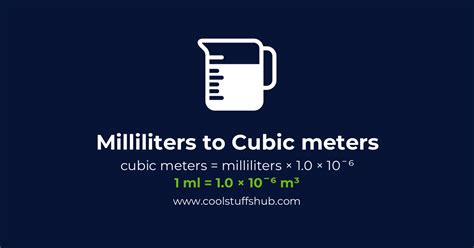How Many Ml In A Cubic Meter
listenit
Mar 27, 2025 · 4 min read

Table of Contents
How Many mL in a Cubic Meter? A Comprehensive Guide to Volume Conversion
Understanding volume conversion is crucial in various fields, from cooking and construction to scientific research and industrial engineering. One common conversion that often sparks confusion is determining how many milliliters (mL) are in a cubic meter (m³). This comprehensive guide will not only answer this question but also delve into the underlying principles, provide practical examples, and offer helpful tips for accurate conversions.
Understanding the Units: mL and m³
Before jumping into the conversion, let's define the units involved:
-
Milliliter (mL): A unit of volume in the metric system. It's a relatively small unit, often used for measuring liquids in everyday contexts like cooking or medicine. Think of a typical medicine dropper or a small bottle of liquid.
-
Cubic Meter (m³): A unit of volume representing the space occupied by a cube with sides of one meter each. This is a significantly larger unit, commonly used in applications involving large volumes like construction, shipping, or water storage. Imagine a large shipping container or a swimming pool.
The significant difference in scale between mL and m³ highlights the importance of understanding the conversion factor to accurately translate between these units.
The Conversion Factor: From m³ to mL
The key to converting cubic meters to milliliters lies in understanding the relationships within the metric system. The metric system is a decimal system, meaning it's based on powers of 10. This makes conversions relatively straightforward.
Here's the breakdown:
-
Meters to Centimeters: There are 100 centimeters (cm) in one meter (m).
-
Centimeters to Milliliters: One cubic centimeter (cm³) is equivalent to one milliliter (mL). This is a crucial link in our conversion.
-
Cubic Meters to Cubic Centimeters: Since there are 100 cm in 1 m, there are 100 x 100 x 100 = 1,000,000 cm³ in 1 m³. This is because volume is a three-dimensional measurement.
Therefore, combining these steps, we get the conversion factor:
1 m³ = 1,000,000 mL
This means that one cubic meter contains one million milliliters.
Practical Applications and Examples
Let's explore some practical scenarios where understanding this conversion is essential:
Example 1: Water Storage
Imagine a water tank with a volume of 5 m³. To determine the tank's capacity in milliliters, we simply multiply the volume in cubic meters by the conversion factor:
5 m³ * 1,000,000 mL/m³ = 5,000,000 mL
The water tank holds 5,000,000 mL (or 5,000 liters) of water.
Example 2: Concrete Pouring
A construction project requires 2.5 m³ of concrete. To understand the volume in a smaller unit for more precise measurements during the pouring process, we convert:
2.5 m³ * 1,000,000 mL/m³ = 2,500,000 mL
The project needs 2,500,000 mL (or 2,500 liters) of concrete.
Example 3: Laboratory Experiments
A scientific experiment requires 0.002 m³ of a specific solution. For more precise handling in the laboratory, the volume is converted:
0.002 m³ * 1,000,000 mL/m³ = 2000 mL
The experiment needs 2000 mL (or 2 liters) of the solution.
Beyond the Basics: Working with Different Units
While the m³ to mL conversion is fundamental, you might encounter scenarios involving other units. The principles remain consistent: leverage the power of the metric system's decimal structure.
Here are a few examples:
-
Liters (L): 1 liter is equal to 1000 mL. Therefore, to convert cubic meters to liters, you can use the conversion factor: 1 m³ = 1000 L.
-
Cubic Centimeters (cm³): As mentioned earlier, 1 cm³ = 1 mL. This simplifies conversions between these two units.
-
Other Metric Prefixes: The metric system employs prefixes like kilo (k, 1000), mega (M, 1,000,000), and so on. These prefixes can be used to extend the conversions to larger or smaller volumes.
Tips for Accurate Conversions
-
Use a Calculator: For complex conversions or large numbers, a calculator is highly recommended to minimize errors.
-
Double-Check Your Work: Always verify your calculations to ensure accuracy.
-
Understand the Context: The best unit to use depends on the specific application. Choose the unit that provides the most practical and manageable numbers for your task.
-
Employ Dimensional Analysis: Dimensional analysis (also known as unit analysis) is a powerful technique to ensure your conversions are correct. It involves writing out the units and canceling them out to obtain the desired units.
Conclusion: Mastering Volume Conversions
Understanding how many milliliters are in a cubic meter is a vital skill with broad applications across numerous fields. By grasping the conversion factor of 1 m³ = 1,000,000 mL and applying the principles of the metric system, you can confidently tackle volume conversion problems, ensuring accuracy and efficiency in your work. Remember to utilize appropriate tools, double-check your calculations, and select the most practical unit for your specific context. Mastering these conversions empowers you to work with volume measurements with confidence and precision.
Latest Posts
Latest Posts
-
5 6 To The Power Of 2
Mar 30, 2025
-
How Many Electrons Can The P Sublevel Hold
Mar 30, 2025
-
Square Root Of Times Square Root Of
Mar 30, 2025
-
What Is The Molar Mass Of Copper Ii Sulfate Cuso4
Mar 30, 2025
-
Is 87 Prime Or Composite Number
Mar 30, 2025
Related Post
Thank you for visiting our website which covers about How Many Ml In A Cubic Meter . We hope the information provided has been useful to you. Feel free to contact us if you have any questions or need further assistance. See you next time and don't miss to bookmark.
